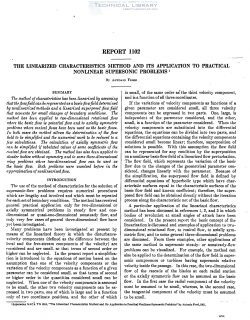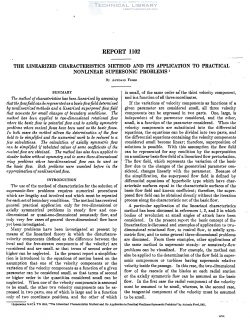naca-report-1102

- Version
- 195 Downloads
- 2.18 MB File Size
- 1 File Count
- September 7, 2016 Create Date
- September 7, 2016 Last Updated
National Advisory Committee for Aeronautics, Report - The Linearized Characteristics Method and its Application to Practical Nonlinear Supersonic Problems

The method of characteristics has been linearized by assuming
that the flowfield can be represented asa basic flowfield determined
by nonlinearised methods and a linearized superposed flow field
that accounts for small changes of boundary conditions. The
method has been applied to two-dimensional rotational flow
where the basic flow is potential flow and to axially symmetric
problems where conical flows have been used as the basic flows.
In. both cases the method allows the determination of the flow
field to be simplified and the numerical work to be reduced to a
few calculations. The calculation of axially symmetric flow
can be simplified if tabulated mlnes of some coeficients of the
conical flow are obtained. The method has also been applied to
slender bodies without symmetry and to some three-dimensional
icing problems where two-dimensional fimo can be used as
the basic flow. Both problems were unsolved before in the
approximation of nonlinear-iced flow.
The use of the method of characteristics for the solution of
supersonic-flow problems requires numerical procedures
which are lengthy and involved and which must be repeated
for each set of boundary conditions. The method has received
general practical application only for two-dimensional or
axially symmetrical problems in steady flow and one—
dimensional or quasi—one—dimensional nonsteady flow, and
only very few cases of general three-dimensional flow have
yet been investigated.
Many problems have been investigated at present by
means of the linearized theory in which the disturbance-
vclocity components (defined as the difference between the
local and the free-stream components of the velocity) are
considered and are small. so that. terms of second order or
higher can be neglected. In the present report a simplifica—
tion is introduced in the equations of motion based on the
assumption that one of the velocity components or the
variation of the velocity components as a function of a given
parameter can be considered small, so that terms of second
or higher order in the quantities considered small can be
neglected. When one of the velocity components is assumed
to be small, the other two velocity components can be ex-
pressed in two parts, one of which is large and is a function
only of two coordinate positions.
| File | Action |
|---|---|
| naca-report-1102 The Linearized Characteristics Method and its Application to Practical Nonlinear Supersonic Problems.pdf | Download |

Comment On This Post